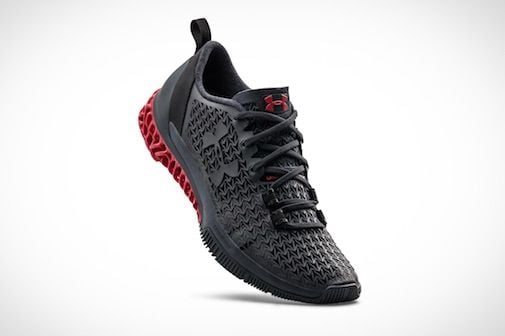
Footwear maker Under Armour announced a small experiment in 3D printing, but it isn’t what you might think.
There have been several attempts at 3D printing footwear in past months and it now seems that Under Armour wants to keep up with the competition by creating their own version of a 3D printed shoe.
It’s called the UA Architech, and it is partially 3D printed. According to a story in Fortune, it includes a “3D printed midsole and a 3D upper design that helps provide a precision fit”. The rest of the high performance training shoe is made from conventional components.
And this experiment is definitely limited in scope, with only ninety-six pairs planned for manufacture. That’s certainly not going to generate sufficient profit to pay for the expense of designing the shoe, so Under Armour obviously has motives other than profit on this USD$300 model.
But let’s discuss the nature of this experiment. While it is 3D printed, it does not make use of one of the technology’s prime benefits: unique, piece-by-piece manufacturing.
This benefit, if realized in a shoe scenario, would involve 3D scanning or measuring a foot and developing a 3D model that precisely matched that – and only that – foot. Perfectly fitting shoes would be achievable by anyone.
That’s not what Under Armour is doing here. Instead, they’re taking an approach very similar to what’s being done in the aerospace industry: 3D print parts that are otherwise not feasible to produce using conventional methods. Aerospace companies are leveraging the technology to produce lighter and stronger parts that offer increased reliability and were inconceivable a few years ago. But they’re all identical.
So if we look at Under Armour, their project seems to be this style: identical parts, but with a unique design that’s not easily done otherwise.
But there is a major difference between the aerospace approach and Under Armour’s: aerospace parts are expected to have high costs anyway, with or without 3D printing expenses, making it far easier to financially justify the use of the technology.
In the case of a shoe, there is no such financial buffer to place 3D printing expenses. While the retail price of the experimental shoes is USD$300, remember that retailers mark up shoes 2-3X their wholesale cost, and thus UA’s cost of manufacture within their wholesale price is much less, perhaps even USD$50 or less. Adding a USD$25 print into that wholesale price could be quite upsetting to business models.
Maybe there’s a reason they’re only doing ninety-six units.
Via Fortune

